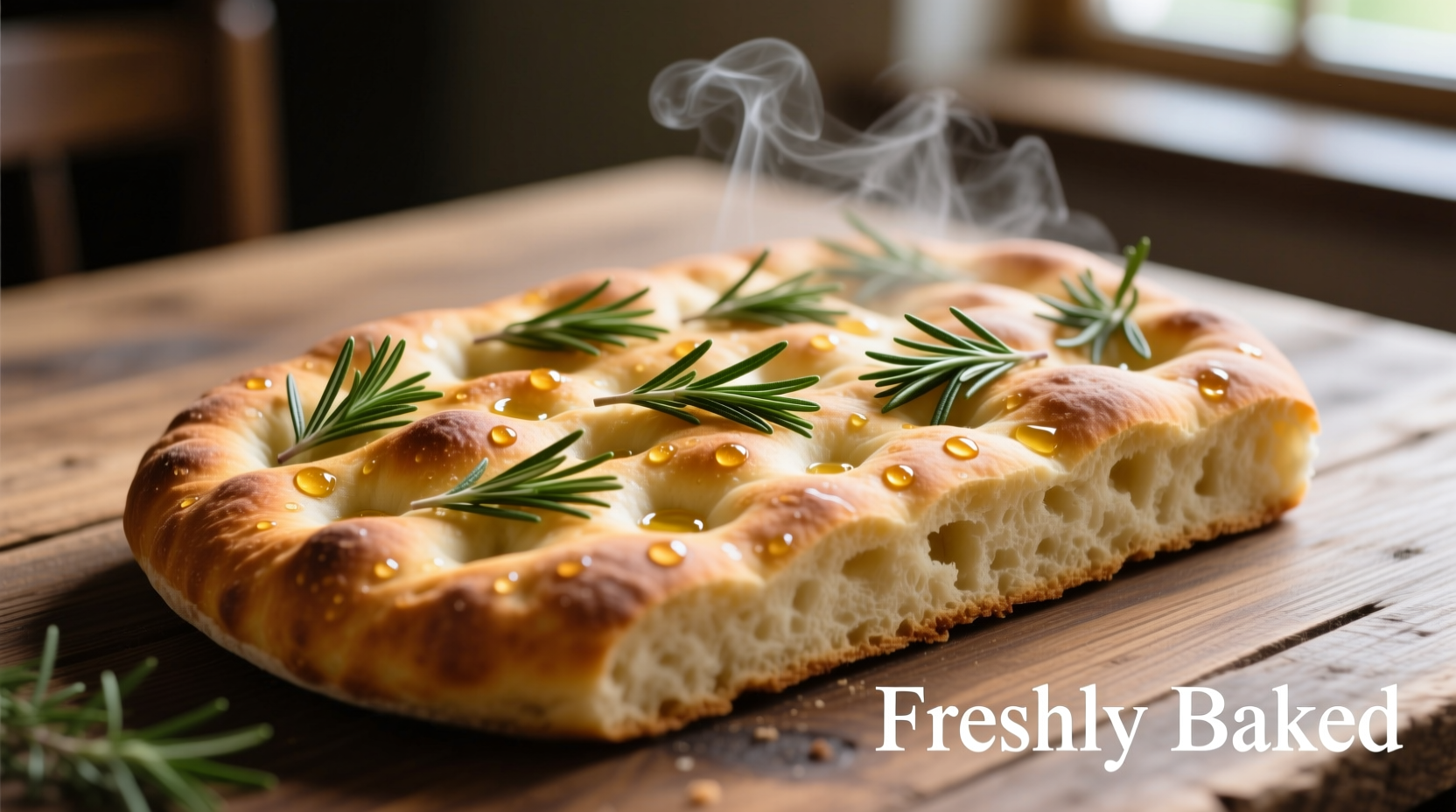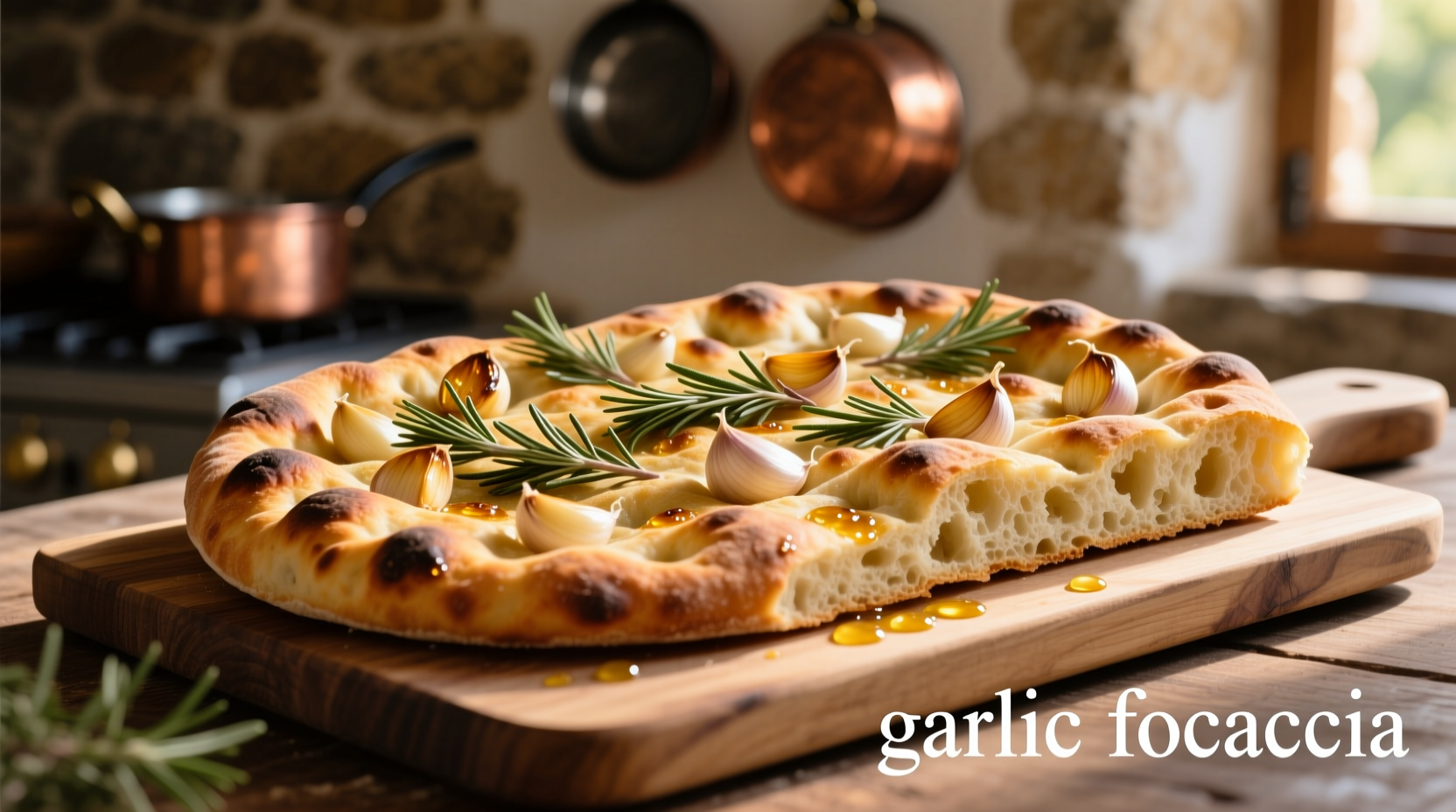The Essential Garlic Focaccia Recipe You'll Master Today
Creating authentic garlic focaccia starts with understanding its foundation: high-quality ingredients and proper technique. Unlike ordinary bread, focaccia's magic happens through slow fermentation that develops complex flavors while creating those characteristic air pockets. The garlic infusion occurs during the final proofing stage, allowing raw garlic to mellow while infusing the olive oil.

Why This Recipe Works Every Time
Professional bakers achieve consistent results by controlling three critical factors: hydration level, fermentation temperature, and dimpling technique. Our tested formula uses a 75% hydration ratio - enough water to create open crumb structure without making the dough unmanageable for home cooks. The 18-hour cold fermentation in the refrigerator develops flavor complexity while giving you scheduling flexibility.
| Traditional Ligurian Focaccia | Modern Garlic Variation | Key Difference |
|---|---|---|
| Plain surface with olive oil | Garlic cloves pressed into dough | Flavor infusion method |
| Sea salt only | Garlic + rosemary + flaky salt | Layered seasoning approach |
| Baked in wood-fired oven | Home oven adaptation | Temperature adjustment |
Focaccia's Journey Through Time
Focaccia's evolution spans millennia, transforming from Roman soldiers' field rations to today's artisanal favorite. Historical records show ancient Romans baked flatbreads directly on hearth stones, calling them "panis focacius" (hearth bread). The modern version emerged in Liguria, Italy around the 15th century when bakers began dimpling the surface to hold olive oil.
Garlic's incorporation followed centuries later as Italian regional cuisines developed. According to Italian Food Central, garlic focaccia became popular in coastal Ligurian towns during the 1800s when garlic-infused olive oil was discovered to enhance preservation - crucial for fishermen's provisions.
Perfecting Your Technique: Proven Methods
Success with garlic focaccia depends on mastering these three elements:
Dough Handling Secrets
Resist the urge to add excess flour during kneading. Proper focaccia dough should feel sticky but cohesive. The "slap and fold" technique developed by artisan bakers creates superior gluten development without overworking the dough. Perform four sets of folds at 30-minute intervals during the first rise.
Fermentation Timing Guide
Cold fermentation produces more complex flavors but requires precise timing:
- 12 hours: Mild flavor, minimal sourness
- 18 hours: Optimal balance of flavor and texture
- 24+ hours: Pronounced sourdough notes (risk of over-fermentation)
Baking Temperature Strategy
Preheat your oven and baking surface to 450°F (230°C). The initial high heat creates "oven spring" - that crucial burst of expansion that forms air pockets. After 15 minutes, reduce to 400°F (200°C) to finish cooking without burning the garlic topping.
When Garlic Focaccia Shines (And When It Doesn't)
Understanding context boundaries ensures your focaccia serves its purpose perfectly:
- Ideal for: Sandwich bases, soup accompaniments, appetizer platters
- Avoid when: Serving with delicate seafood (garlic overpowers)
- Best pairing: Hearty bean soups, tomato-based dishes, roasted vegetables
- Storage limitation: Loses crispness after 24 hours (best consumed fresh)
Creative Variations Worth Trying
Once you've mastered the classic version, experiment with these professional variations:
Roasted Garlic Infusion
Replace raw garlic with roasted cloves for a sweeter, more complex flavor. Roast whole bulbs at 400°F (200°C) for 30 minutes until soft and caramelized.
Lemon-Garlic Brightness
Add 2 tablespoons fresh lemon zest to the dough and finish with lemon slices on top. The acidity balances the richness of olive oil.
Herb-Infused Olive Oil
Steep rosemary, thyme, and sage in warm olive oil for 2 hours before using. This creates a more nuanced herbal flavor than adding dried herbs directly.
Troubleshooting Common Issues
Even experienced bakers encounter these focaccia challenges:
Dense, Heavy Texture
Cause: Under-proofed dough or excessive flour
Solution: Extend final proof to 90 minutes at room temperature. Measure flour by weight (1kg flour = 600g water)
Burnt Garlic Topping
Cause: Garlic exposed to direct high heat
Solution: Add garlic during last 10 minutes of baking, or cover loosely with foil
Sticking to Pan
Cause: Insufficient oil or improper pan preparation
Solution: Use 1/4 cup high-quality olive oil in pan before adding dough
Preserving Freshness: Storage Techniques
Garlic focaccia maintains quality through these methods:
- Same-day: Store uncovered at room temperature
- Next day: Re-crisp in 375°F (190°C) oven for 8 minutes
- Freezing: Wrap tightly in foil, freeze up to 3 months
- Avoid: Refrigeration (accelerates staling)











 浙公网安备
33010002000092号
浙公网安备
33010002000092号 浙B2-20120091-4
浙B2-20120091-4